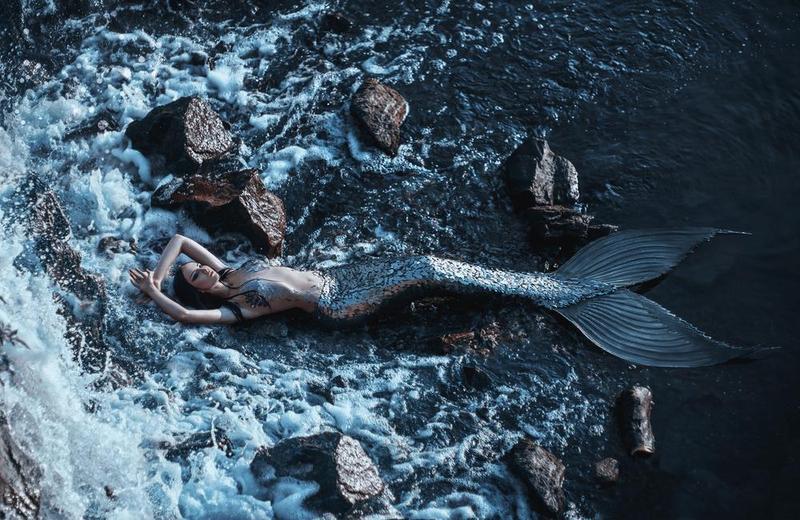What Mythology says about Mermaids
What Mythology says about Mermaids
A mermaid is a mythological marine creature with a human head and torso and the tail of a water animal such as a fish. The word is a compound of mere, the Old English word for “sea,” and maid, a woman. The male alternative is a merman, but the word mermaid is sometimes used for males. Different cultures throughout the globe have similar figures, usually shown without clothing.
Much like sirens, mermaids would sometimes sing to people and gods and enchant them, distracting them from their work and making them walk off the deck or run their ships aground. Other tales have them squeezing the life out of drowning men while attempting to rescue them. They are also known to take humans down to their underwater kingdoms.
In Hans Christian Andersen’s The Little Mermaid it is told that they forget that humans cannot breathe underwater, while others say they drown men out of spite.
The sirens of Greek mythology are sometimes depicted in later folklore as mermaid-like; in fact, some languages use the same word for both bird and fish creatures, such as the Maltese word ‘sirena’. Other related kinds of mythical or legendary creatures are water fairies (e.g. various water nymphs) and selkies, animals that can transform themselves from seals to humans.
The first known mermaid stories appeared in Assyria, ca. 1000 BC. Atargatis, the mother of Assyrian queen Semiramis, was a goddess who loved a mortal shepherd and in the process killed him. Ashamed, she jumped into a lake to take the shape of a fish, but the waters would not hide her divine beauty. So, she took the form of a mermaid - human above the waist, fish below - though the earliest representations of Atargatis showed her as being a fish with a human head and legs, similar to the Babylonian Ea.
The Greeks knew Atargatis under the name Derketo. Prior to 546 BC, the Milesian philosopher Anaximander proposed that mankind had sprung from an aquatic species of animal. He believed that people, with their extended infancy, could not have survived early on. This idea reappeared as the Aquatic ape hypothesis in the twentieth century.
A popular Greek legend has Alexander the Great’s sister, Thessalonike, turn into a mermaid after she died. She lived, it was told, in the Aegean and when sailors would meet her, she would ask them only one question: “Is Alexander the king alive?”, to which the right answer would be “He lives and still rules”. Any other answer would spur her into a rage, where she transformed into a Gorgon and meant doom for the ship and every sailor onboard.
The Arabian Nights (One Thousand and One Nights) consists of a few stories featuring “Sea People”, such as Djullanar the Sea-girl. Unlike the depiction in other mythologies, these are anatomically identical to land-bound humans, differing only in their ability to breathe and live underwater. They can (and do) interbreed with land humans, the kids of such unions sharing in the ability to live underwater.
In another Arabian Nights story, “Abdullah the Fisherman and Abdullah the Merman”, the protagonist Abdullah the Fisherman gains the ability to breathe underwater and finds an underwater submarine society that is depicted as an inverted reflection of society on land, in that the underwater society follows a type of basic communism where concepts like money and clothing do not exist. Other Arabian Nights tales deal with lost ancient technologies, advanced ancient civilizations that went astray, and catastrophes which overwhelmed them.
In “The Adventures of Bulukiya”, the protagonist Bulukiya’s quest for the herb of immortality leads him to explore the seas, where he meets societies of mermaids.
“Julnar the Sea-Born and Her Son King Badr Basim of Persia” is yet another Arabian Nights tale about mermaids. When sailors arrive the mermaids would sing, but some men are led straight to their doom. If they follow the mermaids’ pleasant and beautiful voices, they do not know what they are doing or where they’re going.
British Isles
Mermaids were noted in British folklore as unlucky omens - both foretelling disaster and provoking it. Several variants of the ballad Sir Patrick Spens show a mermaid speaking to the doomed ships; in some, she tells them they will never see land again, and in others, she claims they are near shore, which they are wise enough to know means the same thing. They can also be a sign of rough weather.
Some mermaids were described as gigantic in size, up to 2000 feet.
Mermaids could also swim up rivers to freshwater lakes. Once, in a lake near his house, the Laird of Lorntie saw, as he believed, a woman drowning, and ran to help her; a servant of his pulled him back, warning that it was a mermaid, and the mermaid screamed after that she would have killed him if it were not for his servant.
On occasion, mermaids could be more beneficent, giving humans means of cure.
Some tales raised the question of whether mermaids had immortal souls to answer it in the negative. The figure of L’ Ban appears as a sanctified mermaid, but she was originally a human being transformed into a mermaid; after three centuries, when Christianity had come to Ireland, she came to be baptized.
Mermen were also noted as wilder and uglier than mermaids, but they were described as having little interest in humans.
Be the first to post a message!
